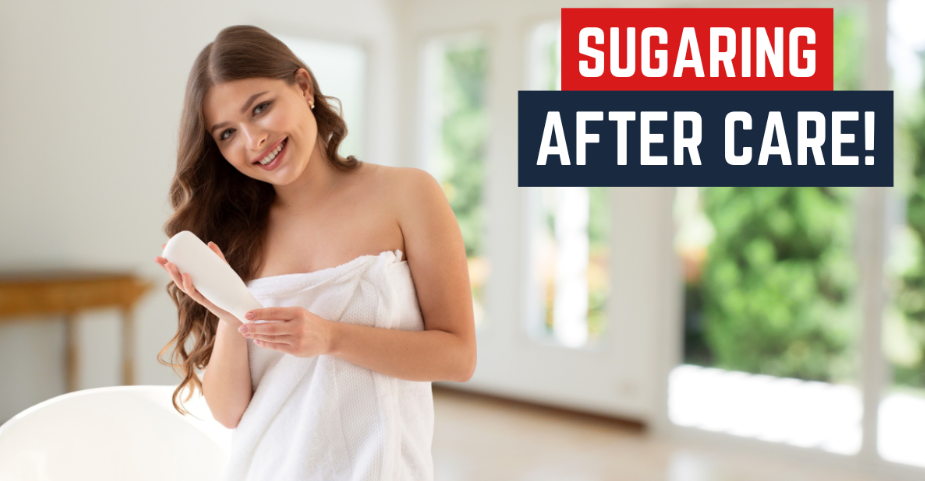Sugar waxing is a popular and natural hair removal method, offering smooth and silky skin without harsh chemicals. While the process is gentle, proper aftercare ensures your skin remains healthy and irritation-free. Many unknowingly make mistakes after waxing that can lead to redness, ingrown hairs, or discomfort.
Understanding the dos and don’ts of sugar wax aftercare allows you to maintain soft, smooth skin while avoiding unnecessary complications. This guide highlights common mistakes to avoid for sugar wax aftercare and provides practical tips to keep your skin in perfect condition post-waxing.
What Is Sugar Waxing?
Sugar waxing is a natural hair removal method using a paste made from sugar, lemon juice, and water. The paste is heated to a warm consistency and applied to the skin in the opposite direction of hair growth. A cloth strip is pressed onto the paste, and when quickly pulled off, it removes hair from the root.
This method is less painful than traditional waxing and is suitable for sensitive skin. It’s also a more eco-friendly alternative, as the ingredients are all-natural and biodegradable. Sugar waxing leaves skin smooth and can be used on various body areas.
Why Does Sugar Wax After Care Matters?
Sugar waxing is a highly effective and natural hair removal method that leaves your skin smooth and soft. However, the process doesn’t end once the waxing session is over. Aftercare is essential to maintain healthy skin, minimize irritation, and prolong the results. Without the proper aftercare, your skin can become prone to issues like ingrown hairs, redness, or dryness. This is why understanding and following a sugar wax aftercare routine is critical for anyone who wants to enjoy the full benefits of this hair removal method.
One of the main reasons aftercare matters is to soothe your skin. Sugar waxing removes hair from the root, which can make your skin sensitive immediately after the procedure. A gentle moisturizer or aloe vera gel can help calm the skin and reduce redness. Keeping the area clean and avoiding harsh products for at least 24-48 hours is crucial to prevent infections or adverse reactions.
Another key reason for prioritizing aftercare is to prevent ingrown hairs. Exfoliation is essential to this process, but it should be done only after 48 hours post-waxing to avoid aggravating the skin. Regular exfoliation helps remove dead skin cells and ensures new hairs grow freely, reducing the risk of them being trapped under the skin.
Proper aftercare also prolongs the results of your sugar wax. Hydrated and healthy skin ensures that regrowth is smoother and less painful during subsequent sessions. Avoiding activities that can irritate your skin, such as swimming in chlorinated water or intense physical exercise, is also recommended for at least 24 hours.
If you’re looking for professional Sugar Waxing Services in Arizona, consult with experienced specialists who can provide personalized advice on aftercare to suit your skin type and needs. They can also guide you on the best practices for maintaining the health of your skin between waxing sessions.
In conclusion, sugar wax aftercare is vital for maintaining smooth and irritation-free skin. Following the proper steps can minimize discomfort, prevent common issues like ingrown hairs, and ensure long-lasting results. Taking care of your skin after sugar waxing is as essential as the procedure for achieving the best outcome.
Sugar Wax After Care Tips for Smooth and Healthy Skin
Sugar waxing is a gentle and natural way to remove unwanted hair. Aftercare is essential to maintain smooth skin, reduce irritation, and ensure lasting results. Here are eight sugar wax aftercare tips:
1. Avoid Touching or Scratching
After waxing, your skin becomes highly sensitive as the hair is removed from the roots, leaving pores open and vulnerable. Touching or scratching the area can introduce dirt and bacteria, leading to irritation, redness, or infections. The urge to scratch can be strong, especially if mild itching, but resisting is vital for proper healing. Wearing loose clothing also reduces friction, further preventing irritation. Keeping your hands clean and away from the waxed area allows the skin to heal faster without complications like breakouts or rashes.
2. Stay Away from Heat
Avoid exposure to heat for 24–48 hours after waxing. Activities such as hot showers, steam rooms, saunas, or intense workouts can irritate freshly waxed skin. Heat further opens the pores, making them more susceptible to bacteria and inflammation. This can lead to redness, bumps, or even folliculitis. Lukewarm water should be used instead when showering. Pat your skin dry gently with a clean towel rather than rubbing, as the skin is sensitive and prone to irritation post-waxing.
3. Moisturize Regularly
Hydrating your skin after waxing is crucial for maintaining softness and preventing dryness. Sugar waxing can remove natural oils from the skin, leaving it feeling tight and dehydrated. Using natural, unscented moisturizers like aloe vera gel, shea butter, or coconut oil can soothe irritation while replenishing lost moisture. Avoid fragranced lotions, as they can cause stinging or discomfort. Regular moisturizing helps relieve the skin and keeps it supple and smooth, promoting a faster recovery. Applying a lightweight moisturizer twice daily enhances skin health post-wax.
4. Exfoliate After 48 Hours
Exfoliation plays a key role in preventing ingrown hairs after waxing. Around two to three days post-waxing, gently exfoliate the area to remove dead skin cells that could clog pores. This step helps hair grow out naturally without curling back into the skin. Use mild scrubs, natural exfoliants, or a soft washcloth to avoid irritation. Over-exfoliating should be avoided as it can damage the sensitive skin. Consistent exfoliation once or twice a week ensures smooth, healthy skin while significantly reducing the chances of ingrown hairs forming.
5. Avoid Sun Exposure
Freshly waxed skin is susceptible to UV rays, making it prone to sunburn or pigmentation issues if exposed to sunlight or tanning beds. To let the skin recover, stay out of direct sun for at least 48 hours after waxing. If you must go outside, apply a broad-spectrum sunscreen with SPF 30 or higher to the waxed area. Sunscreen acts as a protective barrier, reducing irritation and preventing long-term damage. Wearing loose, protective clothing can minimize sun exposure and protect the treated area.
6. Avoid Harsh Products
Scented lotions, perfumes, or alcohol-based products should not be applied to waxed skin for the first few days. These products can irritate the skin, causing redness or stinging sensations. Freshly waxed skin is highly sensitive and requires gentle care. Opt for fragrance-free and hypoallergenic skincare items during this period to avoid unnecessary reactions. Natural remedies like aloe vera gel can be an excellent way to soothe the skin. Keeping the area free from harsh chemicals helps it heal effectively while maintaining smoothness and reducing discomfort.
7. Wear Loose, Breathable Clothing
After waxing, tight or synthetic clothing can rub against the waxed area, causing irritation, redness, and even ingrown hairs. Opting for loose, breathable fabrics such as cotton allows the skin to heal without friction. Avoid tight jeans, leggings, or clothing that traps heat and restricts airflow. Breathable clothing ensures the skin remains cool and reduces the risk of irritation caused by sweating or rubbing. Giving your skin space to recover naturally helps maintain its smooth texture and prevents unnecessary discomfort during healing.
8. Keep the Area Clean
Proper hygiene after waxing is essential to prevent infections and clean the pores. Wash the waxed area with a mild, fragrance-free cleanser and lukewarm water to remove dirt or sweat. Avoid scrubbing the skin or using abrasive tools, which can irritate. Pat the skin dry with a clean towel and avoid reusing dirty towels to minimize the risk of bacterial transfer. Keeping the area clean creates a healthy environment for the skin to heal, ensuring smooth and irritation-free results.
5 Common Mistakes To Avoid for Smooth Skin
Avoiding these common mistakes can maintain smooth, healthy skin and prevent unnecessary issues. Consistent and mindful care is the secret to achieving long-lasting results.
1. Over-Exfoliating
Exfoliation is essential for smooth skin, but overdoing it can harm your skin barrier. Scrubbing too often or using harsh exfoliants can lead to redness, irritation, and dryness. Your skin needs time to regenerate between exfoliating sessions. Stick to exfoliating 2–3 times per week and choose gentle exfoliators. Avoid scrubbing on sensitive or freshly waxed skin to prevent damage and irritation.
2. Skipping Moisturizer
Failing to moisturize regularly is one of the most common skincare mistakes. Hydration is key to maintaining smooth and healthy skin. Without proper moisturizing, your skin can become dry, flaky, and prone to irritation. Use a lightweight, non-comedogenic moisturizer daily, even if you have oily skin. Apply moisturizer after showering when your skin is slightly damp to lock in hydration for better results.
3. Neglecting Sunscreen
Skipping sunscreen is a major mistake that can lead to rough, uneven skin over time. UV rays cause sun damage, leading to premature ageing, hyperpigmentation, and texture issues. Always apply a broad-spectrum sunscreen with SPF 30 or higher, even on cloudy days or indoors. Sunscreen protects your skin and helps maintain a smooth, youthful appearance by preventing long-term damage.
4. Using Harsh Products
Harsh skincare products containing strong fragrances, alcohol, or sulfates can strip your skin of natural oils, leaving it dry and irritated. Many unknowingly use these products, thinking they will cleanse or treat their skin better. Instead, opt for gentle, fragrance-free cleansers and skincare items suited to your skin type. Consistency with mild products is the key to maintaining a smooth and balanced complexion.
5. Ignoring Diet and Hydration
What you consume directly affects your skin’s health. A diet high in processed foods, sugar, and unhealthy fats can lead to dull, uneven skin. Additionally, not drinking enough water can make your skin dry and flaky. Focus on a balanced diet rich in fruits, vegetables, lean proteins, and healthy fats to nourish your skin from within. Staying hydrated by drinking plenty of water helps flush out toxins and keeps your skin supple and glowing.
Conclusion
Taking care of your skin after sugar waxing is essential for maintaining its smoothness and health. Avoiding common mistakes like over-exfoliating, skipping moisturizer, or exposing your skin to the sun ensures that your waxing experience is hassle-free. Following simple yet effective aftercare practices can prevent irritation, ingrown hairs, and other skin issues. Remember, smooth skin isn’t just about the waxing process; it’s about nurturing your skin afterward. You can enjoy long-lasting results and a glowing, silky complexion with mindful care and attention.






